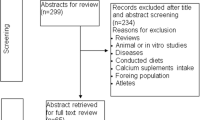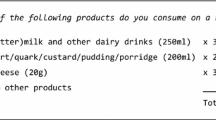Abstract
The calcium content of some foods is inappropriately calculated per 100 kcal, 100 g or 100 mL, or the reference amount customarily consumed (RACC). So, making some food choices based on them to achieve adequate calcium may increase the risks of some chronic diseases. Calculating the calcium content and determining appropriate calcium levels based on the US Food and Drug Administration (FDA), the Codex Alimentarius Commission (CAC), and the proposed method were performed on 8260 food items. Making some food choices based on the FDA and CAC per serving (the serving is derived from the RACC) or CAC per 100 g or 100 mL to achieve adequate calcium exceeded energy needs, which could lead to overweight or obesity. Making some food choices based on the CAC per 100 kcal or CAC per 100 g or 100 mL to achieve adequate calcium did not meet calcium requirements, which could lead to calcium deficiency. Some foods that met calcium requirements were not appropriate food choices based on the CAC per 100 g or 100 mL or CAC per serving to achieve adequate calcium. On the basis of the proposed method, calculating the calcium content and determining appropriate calcium levels in foods are performed by considering RACCs and the energy content of foods. Thus, making food choices based on the proposed method met calcium requirements and did not exceed energy needs.


Similar content being viewed by others
Abbreviations
- CAC:
-
Codex Alimentarius Commission
- FDA:
-
US Food and Drug Administration
- RACC:
-
Reference amount customarily consumed
- DV:
-
Daily value
- NRV:
-
Nutrient reference value
- DRV:
-
Daily reference value
References
Akesowan A, Choonhahirun A, Jariyawaranugoon U (2020) Quality and sensory profile evaluation of gluten-free sapodilla-wild almond seed bar with stevia as partial sugar substitution. Food Res 4:1109–1115
Alrashood ST, Al-Asmari AK, Alotaibi AK, Manthiri RA, Rafatullah S, Hasanato RM et al (2020) Protective effect of lyophilized sapodilla (Manilkara zapota) fruit extract against CCl4-induced liver damage in rats. Saudi J Biol Sci 27:2373–2379
Balk EM, Adam GP, Langberg VN, Earley A, Clark P, Ebeling PR (2017) Global dietary calcium intake among adults: a systematic review. Osteoporos Int 28:3315–3324
Bass JK, Chan GM (2006) Calcium nutrition and metabolism during infancy. Nutrition 22:1057–1066
CAC (Codex Alimentarius Commission) (2007) Food labelling, 5th edn. Rome: Food and Agriculture Organization of the United Nations and World Health Organization
CAC (Codex Alimentarius Commission) (2013) Guidelines for use of nutrition and health claims (CAC/GL 23-1997 as last amended 2013). Rome: World Health Organization and the Food and Agriculture Organization of the United Nations (Accessed May 25, 2021, at http://www.fao.org/ag/humannutrition/32444-09f5545b8abe9a0c3baf01a4502ac36e4.pdf)
CAC (Codex Alimentarius Commission) (2017) Guidelines on nutrition labelling (CAC/GL 2-1985 as last amended 2017). Rome: World Health Organization and the Food and Agriculture Organization of the United Nations (Accessed May 25, 2021, at http://www.fao.org/fao-who-codexalimentarius/sh-proxy/en/?lnk=1&url=https%253A%252F%252Fworkspace.fao.org%252Fsites%252Fcodex%252FStandards%252FCXG%2B2-1985%252FCXG_002e.pdf)
Cai TD, Chang KC, Shih MC, Hou HJ, Ji M (1997) Comparison of bench and production scale methods for making soymilk and tofu from 13 soybean varieties. Food Res Int 30:659–668
Cashman KD (2002) Calcium intake, calcium bioavailability and bone health. Br J Nutr 87:S169–S177
Faustino JMF, Barroca MJ, Guiné RPF (2007) Study of the drying kinetics of green bell pepper and chemical characterization. Food Bioprod Process 85:163–170
FDA (U.S. Food and Drug Administration) (2018) Reference amounts customarily consumed: list of products for each product category: guidance for industry. Washington, DC: U.S. Food and Drug Administration (Accessed May 25, 2021, at https://www.fda.gov/media/102587/download)
Fisberg M, Machado R (2015) History of yogurt and current patterns of consumption. Nutr Rev 73:4–7
Fischer PR, Thacher TD, Pettifor JM (2008) Pediatric vitamin D and calcium nutrition in developing countries. Rev Endocr Metab Disord 9:181–192
Fulgoni VL, Keast DR, Bailey RL, Dwyer J (2011) Foods, fortificants, and supplements: where do Americans get their nutrients? J Nutr 141:1847–1854
Fung AC, Lopez A, Cooler FW (1978) Essential elements in fresh and in frozen spinach and collards. J Food Sci 43:897–899
Gahruie HH, Eskandari MH, Mesbahi G, Hanifpour MA (2015) Scientific and technical aspects of yogurt fortification: a review. Food Sci Human Wellness 4:1–8
González-Martı́nez C, Becerra M, Cháfer M, Albors A, Carot JM, Chiralt A (2002) Influence of substituting milk powder for whey powder on yoghurt quality. Trends Food Sci Technol 13:334–340
He FJ, Chen JQ (2013) Consumption of soybean, soy foods, soy isoflavones and breast cancer incidence: differences between Chinese women and women in Western countries and possible mechanisms. Food Sci Human Wellness 2:146–161
IOM (Institute of Medicine) (2010) Examination of front-of-package nutrition rating systems and symbols: phase I report. Washington, DC: The National Academies Press
IOM (Institute of Medicine) (2011) Dietary reference intakes for calcium and vitamin D. Washington, DC: The National Academies Press
Jadon KS, Shah R, Gour HN, Sharma P (2016) Management of blight of bell pepper (Capsicum annuum var. grossum) caused by Drechslera bicolor. Braz J Microbiol 47:1020–1029
Jalili M (2016) Chemical composition and sensory characteristics of Feta cheese fortified with iron and ascorbic acid. Dairy Sci Technol 96:579–589
Jung WK, Moon SH, Kim SK (2006) Effect of chitooligosaccharides on calcium bioavailability and bone strength in ovariectomized rats. Life Sci 78:970–976
Kubra IR, Kumar D, Jagan Mohan Rao L (2016) Emerging trends in microwave processing of spices and herbs. Crit Rev Food Sci Nutr 56:2160–2173
Mamedov MI, Pyshnaya ON, Dzhos YA, Matyukina AA, Golubkina NA, Nadezhkin SM, Pivovarov VF (2015) Quality characteristics of paprika pepper varieties (Capsicum annum L.) under Moscow Oblast conditions. Russ Agric Sci 41:326–330
Motawee MM, McMahon DJ (2009) Fate of aflatoxin M1 during manufacture and storage of feta cheese. J Food Sci 74:T42–T45
Mudgil D, Barak S, Darji P (2016) Development and characterization of functional cultured buttermilk utilizing Aloe vera juice. Food Biosci 15:105–109
Oktem A, Oktem AG, Emeklier HY (2010) Effect of nitrogen on yield and some quality parameters of sweet corn. Commun Soil Sci Plant Anal 41:832–847
Pennington JA, Wilson DB, Young BE, Johnson RD, Vanderveen JE (1987) Mineral content of market samples of fluid whole milk. J Am Diet Assoc 87:1036–1042
Riciputi Y, Serrazanetti DI, Verardo V, Vannini L, Caboni MF, Lanciotti R (2016) Effect of fermentation on the content of bioactive compounds in tofu-type products. J Funct Foods 27:131–139
Smith TM, Kolars JC, Savaiano DA, Levitt MD (1985) Absorption of calcium from milk and yogurt. Am J Clin Nutr 42:1197–1200
Toba Y, Takada Y, Tanaka M, Aoe S (1999) Comparison of the effects of milk components and calcium source on calcium bioavailability in growing male rats. Nutr Res 19:449–459
Tordoff MG, Sandell MA (2009) Vegetable bitterness is related to calcium content. Appetite 52:498–504
Tseng RYL, Smith-Nury E, Chang YS (1977) Calcium and phosphorus contents and ratios in tofu as affected by the coagulants used. Home Econ Res J 6:171–175
USDA ARS (U.S. Department of Agriculture ARS) (2016) USDA National Nutrient Database for Standard Reference, release 28. Washington, DC: U.S. Department of Agriculture ARS (Accessed May 25, 2021, at https://www.ars.usda.gov/Services/docs.htm?docid=8964)
Vatanparast H, Dolega-Cieszkowski JH, Whiting SJ (2009) Many adult Canadians are not meeting current calcium recommendations from food and supplement intake. Appl Physiol Nutr Metab 34:191–196
Wallace TC, McBurney M, Fulgoni VL (2014) Multivitamin/mineral supplement contribution to micronutrient intakes in the United States, 2007–2010. J Am Coll Nutr 33:94–102
Zawadzki A, Paganelli MO, Garcia AC, Skibsted LH (2020) Hydroxycarboxylate combinations for increasing solubility and robustness of supersaturated solutions of whey mineral residues. Food Res Int 136:109525
Author information
Authors and Affiliations
Corresponding author
Ethics declarations
Ethical Approval
This article does not contain any studies with human participants or animals performed by any of the authors.
Informed Consent
Not applicable.
Conflict of Interest
Abed Forouzesh declares that he has no conflict of interest. Fatemeh Forouzesh declares that she has no conflict of interest. Sadegh Samadi Foroushani declares that he has no conflict of interest. Abolfazl Forouzesh declares that he has no conflict of interest. Eskandar Zand declares that he has no conflict of interest.
Additional information
Publisher’s Note
Springer Nature remains neutral with regard to jurisdictional claims in published maps and institutional affiliations.
Rights and permissions
About this article
Cite this article
Forouzesh, A., Forouzesh, F., Samadi Foroushani, S. et al. A New Method for Calculating Calcium Content and Determining Appropriate Calcium Levels in Foods. Food Anal. Methods 15, 16–25 (2022). https://doi.org/10.1007/s12161-021-02084-3
Received:
Accepted:
Published:
Issue Date:
DOI: https://doi.org/10.1007/s12161-021-02084-3




